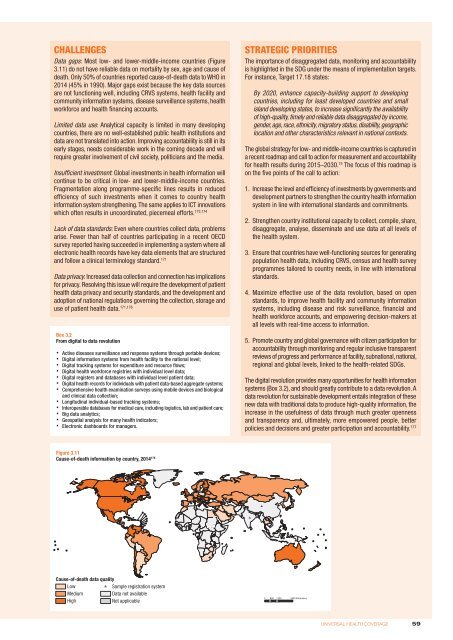You also want an ePaper? Increase the reach of your titles
YUMPU automatically turns print PDFs into web optimized ePapers that Google loves.
CHALLENGES<br />
Data gaps: Most low- and lower-middle-income countries (Figure<br />
3.11) do not have reliable data on mortality by sex, age and cause of<br />
death. Only 50% of countries reported cause-of-death data <strong>to</strong> WHO in<br />
2014 (45% in 1990). Major gaps exist because the key data sources<br />
are not functioning well, including CRVS systems, health facility and<br />
community information systems, disease surveillance systems, health<br />
workforce and health financing accounts.<br />
Limited data use: Analytical capacity is limited in many developing<br />
countries, there are no well-established public health institutions and<br />
data are not translated in<strong>to</strong> action. Improving accountability is still in its<br />
early stages, needs considerable work in the coming decade and will<br />
require greater involvement of civil society, politicians and the media.<br />
Insufficient investment: Global investments in health information will<br />
continue <strong>to</strong> be critical in low- and lower-middle-income countries.<br />
Fragmentation along programme-specific lines results in reduced<br />
efficiency of such investments when it comes <strong>to</strong> country health<br />
information system strengthening. The same applies <strong>to</strong> ICT innovations<br />
which often results in uncoordinated, piecemeal efforts. 173,174<br />
Lack of data standards: Even where countries collect data, problems<br />
arise. Fewer than half of countries participating in a recent OECD<br />
survey reported having succeeded in implementing a system where all<br />
electronic health records have key data elements that are structured<br />
and follow a clinical terminology standard. 171<br />
Data privacy: Increased data collection and connection has implications<br />
for privacy. Resolving this issue will require the development of patient<br />
health data privacy and security standards, and the development and<br />
adoption of national regulations governing the collection, s<strong>to</strong>rage and<br />
use of patient health data. 171,176<br />
Box 3.2<br />
From digital <strong>to</strong> data revolution<br />
• Active diseases surveillance and response systems through portable devices;<br />
• Digital information systems <strong>from</strong> health facility <strong>to</strong> the national level;<br />
• Digital tracking systems for expenditure and resource flows;<br />
• Digital health workforce registries with individual level data;<br />
• Digital registers and databases with individual level patient data;<br />
• Digital health records for individuals with patient data-based aggregate systems;<br />
• Comprehensive health examination surveys using mobile devices and biological<br />
and clinical data collection;<br />
• Longitudinal individual-based tracking systems;<br />
• Interoperable databases for medical care, including logistics, lab and patient care;<br />
• Big data analytics;<br />
• Geospatial analysis for many health indica<strong>to</strong>rs;<br />
• Electronic dashboards for managers.<br />
STRATEGIC PRIORITIES<br />
The importance of disaggregated data, moni<strong>to</strong>ring and accountability<br />
is highlighted in the SDG under the means of implementation targets.<br />
For instance, Target 17.18 states:<br />
By 2020, enhance capacity-building support <strong>to</strong> developing<br />
countries, including for least developed countries and small<br />
island developing states, <strong>to</strong> increase significantly the availability<br />
of high-quality, timely and reliable data disaggregated by income,<br />
gender, age, race, ethnicity, migra<strong>to</strong>ry status, disability, geographic<br />
location and other characteristics relevant in national contexts.<br />
The global strategy for low- and middle-income countries is captured in<br />
a recent roadmap and call <strong>to</strong> action for measurement and accountability<br />
for health results during 2015–2030. 75 The focus of this roadmap is<br />
on the five points of the call <strong>to</strong> action:<br />
1. Increase the level and efficiency of investments by governments and<br />
development partners <strong>to</strong> strengthen the country health information<br />
system in line with international standards and commitments.<br />
2. Strengthen country institutional capacity <strong>to</strong> collect, compile, share,<br />
disaggregate, analyse, disseminate and use data at all levels of<br />
the health system.<br />
3. Ensure that countries have well-functioning sources for generating<br />
population health data, including CRVS, census and health survey<br />
programmes tailored <strong>to</strong> country needs, in line with international<br />
standards.<br />
4. Maximize effective use of the data revolution, based on open<br />
standards, <strong>to</strong> improve health facility and community information<br />
systems, including disease and risk surveillance, financial and<br />
health workforce accounts, and empowering decision-makers at<br />
all levels with real-time access <strong>to</strong> information.<br />
5. Promote country and global governance with citizen participation for<br />
accountability through moni<strong>to</strong>ring and regular inclusive transparent<br />
reviews of progress and performance at facility, subnational, national,<br />
regional and global levels, linked <strong>to</strong> the health-related SDGs.<br />
The digital revolution provides many opportunities for health information<br />
systems (Box 3.2), and should greatly contribute <strong>to</strong> a data revolution. A<br />
data revolution for sustainable development entails integration of these<br />
new data with traditional data <strong>to</strong> produce high-quality information, the<br />
increase in the usefulness of data through much greater openness<br />
and transparency and, ultimately, more empowered people, better<br />
policies and decisions and greater participation and accountability. 177<br />
Figure 3.11<br />
Cause-of-death information by country, 2014 175 #<br />
# #<br />
Cause-of-death data quality<br />
Low<br />
Medium<br />
High<br />
# Sample registration system<br />
Data not available<br />
Not applicable<br />
0 1700 3400<br />
850 Kilometres<br />
UNIVERSAL HEALTH COVERAGE<br />
59


